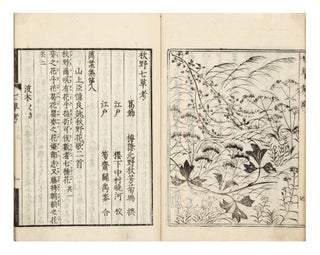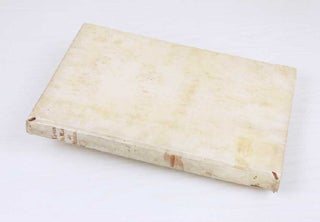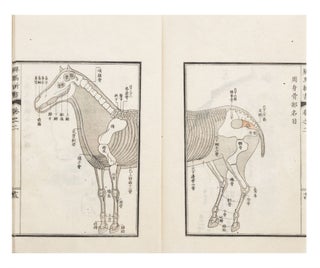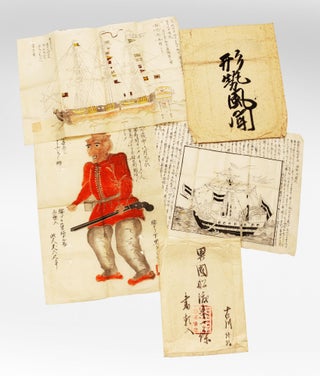A Very Rare Movable Type Koya-ban
Kohitsu shushusho [or] Kohitsu shuisho [or] Kohitsusho [Collections of Old Writings].
Several fine woodcuts in Vol. I. Ten columns, 20 characters per column. 86; 95; 76 folding leaves. Six parts in three vols. Large 8vo (280 x 200 mm.), orig. brown wrappers, orig. manuscript title labels on upper covers, new stitching. From the final leaf of Vol. III: “Koya san Ojoin…Kan’ei 12” [“printed at Mount Koya in Ojoin, 1635“].
First edition of this very rare (not in WorldCat) and handsome movable type book, printed on Mount Koya, south of Osaka, the center of the Shingon sect of Japanese Buddhism. This is a most unusual example of fukun shokuban, a technique that enabled typesetters to also add (shoku, “plant”) small reading marks alongside the right side of the main columns of movable characters. Kawase states in Vol. I, p. 313, in a discussion of our book, that this technique mainly existed in the Kan’ei period (1624-43) and that the name most commonly associated with this technique is “Sen’o,” whose name is printed on the leaf of the colophon (Kawase makes a typo here by giving the name as “Osen,” reversing the characters). The illustration of the colophon, appearing in Vol. III, p. 45, of Kawase’s bibliography, is identical to our colophon. Kawase states that “Sen’o” was affiliated with Hokoin on Mount Koya. This technique of fukun shokuban was first developed on Mount Hiei outside of Kyoto in the 13th century (“Eizan-ban”).
“From late Heian, under the stimulus of Kyoto and Nara, the great Shingon monastery complex on Mount Koya began to publish books in large numbers, chiefly Shingon scriptures…Koya-ban publications closely resemble Kasuga-ban in their use of black ink, but the kanji stokes are generally thinner than those in Kasuga editions. Some fine examples of Koyasan printing were produced in the Kamakura period, distinguished for their bold, regular and large-sized script, but the quality of printing declined from the mid-fourteenth century onwards. Printing on Koyasan revived again in the movable-type period from the Keicho to Kan’ei periods, and blockprinted as well as movable-type editions were published in large numbers.”–K.B. Gardner, “Centres of Printing in Medieval Japan: late Heian to early Edo period” in British Library Occasional Papers 11. Japanese Studies (ed. by Yu-Ying Brown), London: 1990, p. 162.
Inyu (1435-1519), was a Shingon scholar priest who pursued his studies in three temples on Mount Koya: Muryokoin, Kangoji, and Sanneji. This is a collection of earlier Shingon Buddhist writings with Inyu’s commentaries.
In essentially fine condition, preserved in a chitsu. There is some worming, well-repaired, to the wrappers. There is also worming to the text, which is sometimes well-repaired and sometimes not repaired at all. Minor dampstaining, mostly marginal.
❧ The Union Catalogue of Early Japanese Books locates only one copy, at Koyasan Sanpoin.
Price: $15,000.00
Item ID: 7030

![Item ID: 7030 Kohitsu shushusho [or] Kohitsu shuisho [or] Kohitsusho [Collections of Old Writings]. INYU.](https://jonathanahill.cdn.bibliopolis.com/pictures/7030.jpg?width=768&height=1000&fit=bounds&auto=webp&v=1588723019)
![Kohitsu shushusho [or] Kohitsu shuisho [or] Kohitsusho [Collections of Old Writings].](https://jonathanahill.cdn.bibliopolis.com/pictures/7030_2.jpg?width=320&height=427&fit=bounds&auto=webp&v=1588723019)
![Kohitsu shushusho [or] Kohitsu shuisho [or] Kohitsusho [Collections of Old Writings].](https://jonathanahill.cdn.bibliopolis.com/pictures/7030_3.jpg?width=320&height=427&fit=bounds&auto=webp&v=1588723019)
![Kohitsu shushusho [or] Kohitsu shuisho [or] Kohitsusho [Collections of Old Writings].](https://jonathanahill.cdn.bibliopolis.com/pictures/7030_4.jpg?width=320&height=427&fit=bounds&auto=webp&v=1588723019)
![Kohitsu shushusho [or] Kohitsu shuisho [or] Kohitsusho [Collections of Old Writings].](https://jonathanahill.cdn.bibliopolis.com/pictures/7030_5.jpg?width=320&height=427&fit=bounds&auto=webp&v=1588723019)
![Kohitsu shushusho [or] Kohitsu shuisho [or] Kohitsusho [Collections of Old Writings].](https://jonathanahill.cdn.bibliopolis.com/pictures/7030_6.jpg?width=320&height=427&fit=bounds&auto=webp&v=1588723019)
![Kohitsu shushusho [or] Kohitsu shuisho [or] Kohitsusho [Collections of Old Writings].](https://jonathanahill.cdn.bibliopolis.com/pictures/7030_7.jpg?width=320&height=427&fit=bounds&auto=webp&v=1588723019)



